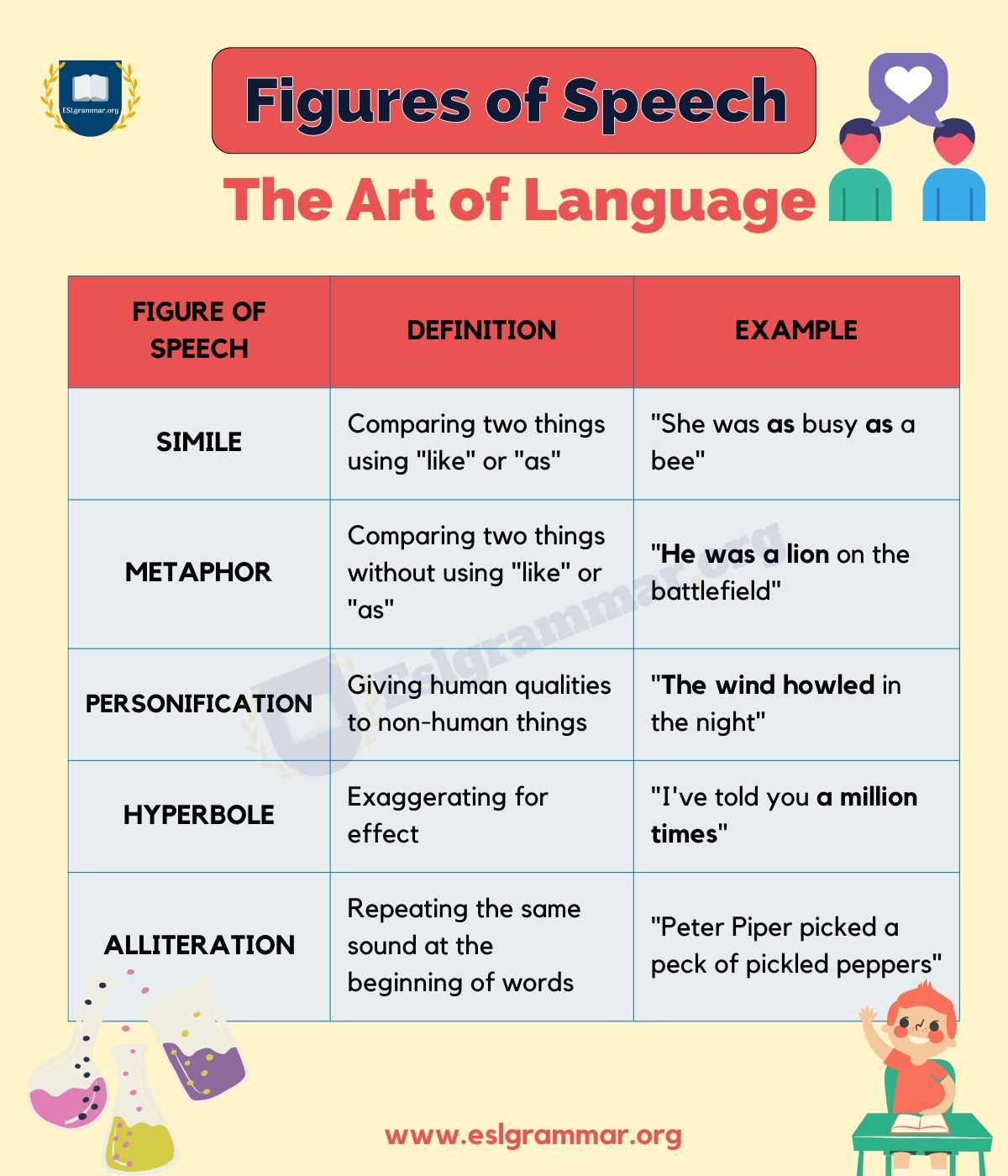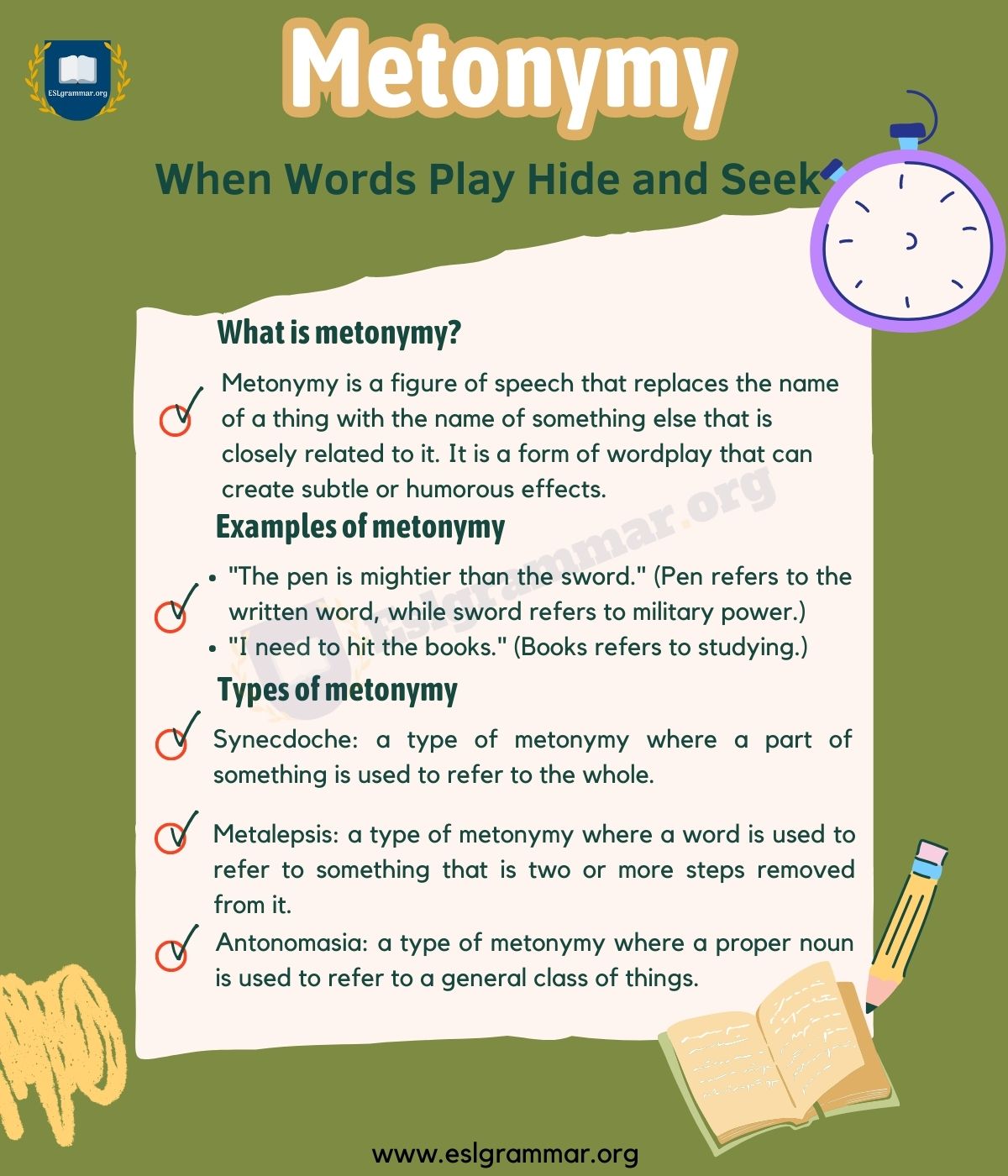Figures of speech are essential components of language that add an extra layer of depth and nuance to communication, enhancing written and spoken content. These devices are used in various forms of literature, including novels, poems, essays, and plays, as well as in everyday conversations. By intentionally deviating from the literal meanings of words or phrases, figures of speech grant writers and speakers the ability to emphasize, clarify, and enrich their message.
There are numerous types of figures of speech, each with its unique characteristics and stylistic effects. Some common examples include metaphors, similes, hyperboles, and personification. These instruments of figurative language allow individuals to create vivid images, comparisons, and expressions, capturing the reader or listener’s imagination and conveying ideas more effectively.
Incorporating figures of speech into one’s writing or speech can make a significant impact; it can make the text more engaging, help the audience connect with the content on a deeper level, and provide an element of creativity. The skillful use of these literary devices can also set one apart as an exceptional writer or speaker, leaving a lasting impression on readers and listeners alike.
Contents
Types of Figures of Speech
Metaphor
A metaphor is a figure of speech where a word or phrase is used to represent something else, usually by suggesting a common quality or characteristic between the two. For example, “Time is a thief” is a metaphor that implies time steals moments from us, just like a thief would.
Simile
A simile is a type of metaphor that uses “like” or “as” to make a direct comparison between two unlike things. An example of a simile is, “Her smile is as warm as the sun.”
Hyperbole
Hyperbole is a figure of speech that uses extreme exaggeration to emphasize a point or evoke humor. For example, “I’m so hungry I could eat a horse.”
Irony
Irony is a figure of speech in which the intended meaning of a word or expression is opposite to its usual or literal meaning. For instance, saying “How nice!” when something unpleasant happens.
Oxymoron
An oxymoron is a figure of speech in which two contradictory terms are used together, such as “deafening silence” or “jumbo shrimp.”
Paradox
A paradox is a statement that seems contradictory or absurd but may express a deeper truth. An example is, “The more you learn, the more you realize how little you know.”
Personification
Personification is a figure of speech in which human qualities are attributed to non-human things or abstract concepts. For example, “The wind whispered through the trees.”
Pun
A pun is a play on words that exploits the multiple meanings or similar sounds of words, often to create a humorous effect. An example is, “I used to be a baker, but I couldn’t make enough dough.”
Alliteration
Alliteration is the repetition of the same consonant sound at the beginning of words or syllables in close proximity. For example, “Peter Piper picked a peck of pickled peppers.”
Metonymy
Metonymy is a figure of speech in which a thing or concept is referred to by the name of something closely associated with it, such as “the White House” to mean the US president’s administration.
Antithesis
Antithesis is a figure of speech in which contrasting ideas are expressed by the use of parallel structures. For instance, “To err is human; to forgive, divine.”
Onomatopoeia
Onomatopoeia is a figure of speech in which words mimic the sound they represent, like “buzz” or “drip.”
Synecdoche
Synecdoche is a figure of speech in which a part represents the whole or vice versa. For example, “all hands on deck” means all crew members should help.
Understatement
Understatement is a figure of speech in which something is expressed with less strength or emphasis than it deserves, often for ironic effect. For instance, “It’s just a scratch” when referring to a deep wound.
Apostrophe
Apostrophe is a figure of speech in which a speaker directly addresses an absent person, an abstract idea, or a thing as if it were present. For example, “O death, where is thy sting?”
Litotes
Litotes is a figure of speech that uses understatement by negating the opposite, often to emphasize a point. An example is, “He’s not the friendliest person” to mean the person is quite unfriendly.
Euphemism
A euphemism is a figure of speech that uses a mild or indirect expression in place of a harsher or more offensive one. For instance, “passed away” instead of “died.”
Anaphora
Anaphora is a figure of speech in which the same word or phrase is repeated at the beginning of successive clauses or sentences for emphasis. For example, “We shall fight on the beaches, we shall fight on the landing grounds, we shall fight in the fields and in the streets.”
Circumlocution
Circumlocution is a figure of speech in which a word or idea is expressed indirectly or in a roundabout way. For instance, “the thing you use to write with that has ink” instead of “pen.”
Assonance
Assonance is the repetition of similar vowel sounds within words in close proximity, often to create a sense of harmony or rhythm. An example is, “The rain in Spain stays mainly in the plain.”
Epigram
An epigram is a concise and witty statement or verse that often contains a paradox or an ironic twist. For example, “I can resist everything except temptation” by Oscar Wilde.
Pleonasm
Pleonasm is a figure of speech in which redundant or unnecessary words are used for emphasis, such as “burning fire” or “free gift.”
Functions and Effects
Rhetorical Effect
Figures of speech serve various functions in language, including producing a rhetorical effect. By using devices such as rhetorical questions, antimetabole, and ellipsis, speakers and writers can clarify, emphasize, or embellish their message in order to create a persuasive argument or profound observation. Rhetorical questions, for instance, are a technique where questions are posed without the expectation of an answer, serving to make an implied point. Antimetabole uses repetition with a reversal of a word order to create a powerful effect, while ellipsis omits words for a purposeful, concise impact.
Emphasis and Balance
Another function of figures of speech is to create emphasis and balance within a text. This can be achieved through devices like antithesis, which places opposite ideas or things next to each other to draw out their contrast. Similarly, the use of antanaclasis can also provide balance by repeating a word with a different meaning in one sentence, adding emphasis and creating intrigue.
Wordplay and Humor
Figures of speech can bring a sense of wordplay and humor to a text, making it more engaging and memorable. Devices like puns, anthimeria, and periphrasis help create a playful and lighthearted tone while still maintaining the writer’s intended message. Puns use similar or identical words with different meanings to create humor, whereas anthimeria involves using a word from one part of speech as another for a witty effect. Periphrasis, on the other hand, is a figurative device that uses more words than necessary to describe something, often for humorous or exaggerated effect.
Emotional and Imaginative Impact
Lastly, figures of speech can also evoke emotional and imaginative responses from audiences. By using vivid language, metaphors, similes, and other figurative techniques, writers and speakers can form mental pictures that enhance a reader or listener’s understanding of a concept or idea. This capacity to create powerful imagery and elicit strong emotions makes figures of speech essential tools in the art of communication.
Frequently Asked Questions
What are common examples of figures of speech?
Some common examples of figures of speech include similes, metaphors, alliteration, personification, and hyperbole. These figures are often used in literature, poetry, and everyday language to create vivid and memorable expressions.
How many types of figures of speech exist?
There are numerous types of figures of speech, with some sources suggesting over 100 different types. However, it’s essential to be familiar with a handful of commonly used figures of speech to improve one’s reading and writing skills.
What are the four most frequently used figures?
The four most frequently used figures of speech are similes, metaphors, alliteration, and personification. Similes compare two things using “like” or “as,” metaphors make direct comparisons between different objects, alliteration is the repetition of consonant sounds, and personification attributes human qualities to non-human entities.
Can you provide examples of 10 different figures of speech?
- Simile: Her smile was as bright as the sun.
- Metaphor: Time is a thief.
- Alliteration: Peter Piper picked a peck of pickled peppers.
- Personification: The wind whispered through the trees.
- Hyperbole: He’s as strong as an ox.
- Onomatopoeia: The bees buzzed in the flowers.
- Oxymoron: The silence was deafening.
- Pun: Time flies like an arrow; fruit flies like a banana.
- Anaphora: We shall fight on the beaches, we shall fight on the landing grounds, we shall fight in the fields and in the streets.
- Irony: The fire station burned down.
What are the 8 main types of figures?
The 8 main types of figures of speech are similes, metaphors, alliteration, personification, hyperbole, onomatopoeia, oxymorons, and puns. These figures of speech each serve different purposes and are used in various contexts to convey vivid imagery and meaning.
Which figures of speech are found in a top 20 list?
In a top 20 list of figures of speech, one might find:
- Simile
- Metaphor
- Alliteration
- Personification
- Hyperbole
- Onomatopoeia
- Oxymoron
- Pun
- Anaphora
- Irony
- Euphemism
- Paradox
- Anadiplosis
- Litotes
- Synecdoche
- Metonymy
- Chiasmus
- Assonance
- Consonance
- Anachronism
These figures of speech are frequently used in literature, speeches, and everyday language to enhance the meaning and impact of language.








